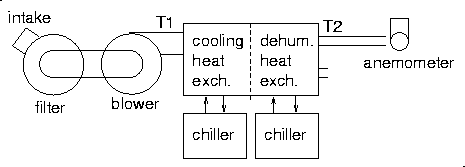
ps version
This is a record of various measurement taken on various components of the air cooling system.
(I)

inlet temperature: 70 deg F
outlet temperature 107 deg F --> temp rise = 37 F
flow velocity 36.7 m/s
tube diameter 2" --> volume flow = 74 l/s
1 l air weighs 1.2 g --> mass flow = 89 g/s
1 lb = 0.45 kg = 0.2 lb/s
specific heat of air 0.24 btu/lb F
1 btu = 0.00029kWh
it takes 0.24 btu to heat 1 lb air by 1 F
0.07 Wh 1 1
0.52 Wh 0.2 37 F
1865 Ws 0.2 37 F
so it takes 1865 Watts to heat the air in the top branch in 1 second. The flow
at B was 33.3 m/s, so the total heat added is about 3560 W.
[The anemometer opening diameter is actually 2 7/32", and if you scale by
that, the power estimate drops to 2900 W. Clearly there are 15% uncertainties
here.]
Empirically, power(W) = 1.12 × DeltaT(°F) × v(m/s)

room temperature = |
69.5°F |
Flow at T2, handheld at the end of the hose: |
52.4 m/s |
Total estimated power removed by the dehumidifier chiller/heat exchanger is only about 185W.
IIIa) The air intake port on the filter housing is a 2 7/8" i.d opening, and I used different blocks of wood to partially block this opening.

| d | T (°F) | v (m/s) | P (in.water) | currents (A) | ||
|---|---|---|---|---|---|---|
| - | 104.7 | 30.4 | 8.5 | |||
| 1 1/8" | ? | 25.5 | 16 | |||
| 1 1/2" | 107 | 21.6 | off scale | 10.5 | 9.8 | 10.6 |
| 1 7/8 | 112 | 15.5 | off scale | 9.0 | 8.5 | 9.1 |
Note that as the flow goes down, the temperature rises. However since the power used by the motor goes down as the flow is restricted, the heat in the airstream must also go down.
IIIb) The manufacturer actually specified that the vane should be installed after the turbine, not before as under IIIa, so I built a blade valve to go between the turbine and the heat exchanger box.

| blockage* | filter pressure (in.water) | v (m/s) | currents (A) | ||
|---|---|---|---|---|---|
| 0% | 9.3 | 25-26 | 12.8 | 11.7 | 12.9 |
| 20% | 9.2 | 26-27 | 12.9 | 11.9 | 13.0 |
| 40% | 7.4 | 23-24 | 12.0 | 11.1 | 12.1 |
| 60% | 4.3 | 17-18 | 10.3 | 9.7 | 10.6 |
| 70% | 2.3 | 11-12 | 9.0 | 8.4 | 9.2 |
| 80% | 1.1 | 7 | 7.6 | 6.9 | 7.5 |
*the blockage is the distance b as a percentage of the hole diameter. Below are plotted the filter underpressure, air flow velocity at the end of the 2" hose, and the currents in the 3 phases to the motor.
